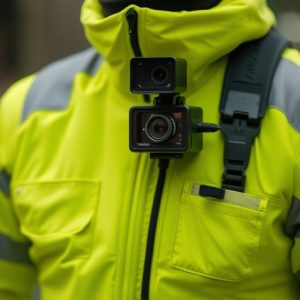Body-Worn Cameras: Enhancing Security with Hidden Lenses
Body-worn hidden cameras are increasingly being utilized in law enforcement, private security, and …….
Body-worn hidden cameras are increasingly being utilized in law enforcement, private security, and for personal safety due to their ability to capture covert video and audio. These devices have advanced features such as high-definition recording, night vision, and various data storage options including onboard memory and cloud services. They offer continuous recording, motion or event-triggered capture, and live streaming capabilities tailored to different use cases. When selecting a body-worn hidden camera, it's important to consider factors like resolution, battery life, field of view, and audio clarity. Legal compliance with surveillance laws, which vary by jurisdiction, is essential. Privacy and ethical considerations necessitate secure data storage and encryption to safeguard recordings from unauthorized access. These cameras are enhancing situational awareness and accountability within various settings. The shift towards more discreet body-worn hidden cameras has transformed surveillance practices, making them a valuable tool for capturing real-time events without disrupting public spaces, thereby improving evidence collection, promoting transparency, and building trust between authorities and citizens. As technology progresses, we can expect continued advancements in the functionality and performance of these devices, solidifying their role as a key player in surveillance technologies.
In an era where security is paramount, the integration of technology into safety protocols has become increasingly sophisticated. Among these advancements, body worn hidden cameras have emerged as a pivotal tool in the realm of surveillance and security. This article delves into the multifaceted role these devices play, from their evolution to their impact on modern security operations. We will explore their capabilities, legal frameworks, and ethical considerations, as well as practical guidance for deploying them effectively. By examining key features of advanced models, real-world applications, and future trends, we aim to provide a comprehensive understanding of how body worn hidden cameras can be leveraged to enhance security efforts. This guide is designed to assist organizations in selecting the most appropriate camera for their specific needs, ensuring that they are well-equipped to harness this technology for optimal protection.
Understanding Body Worn Hidden Cameras: A Comprehensive Guide
Body-worn hidden cameras have become increasingly prominent in various sectors, including law enforcement, private security, and personal safety applications. These devices are designed to discreetly capture video and audio, providing a firsthand perspective of events as they unfold. A key aspect of body-worn hidden cameras is their ability to record interactions without drawing attention to the recording process, which can be crucial for capturing authentic footage in sensitive situations. The technology behind these cameras has advanced significantly, offering features such as high-definition video, night vision capabilities, and data storage options that range from onboard memory to cloud integration. Users can benefit from continuous recording, event-driven triggering, and even live streaming functions, depending on the model and its intended use.
When selecting a body-worn hidden camera, it’s important to consider factors such as the device’s resolution, battery life, field of view, and the quality of its audio capture. Additionally, the legal implications of surveillance must be understood, as laws vary by jurisdiction and govern how, when, and where recording can take place. Privacy concerns are also paramount, and thus, body-worn hidden cameras should only be used in accordance with ethical guidelines and relevant regulations. Security features like encryption and secure data storage are essential to protect recordings from unauthorized access or tampering. Furthermore, the integration of these cameras with other security systems can enhance situational awareness and accountability, making them an indispensable tool for those tasked with ensuring safety and security in their environments.
1. The Evolution of Surveillance: From Overt to Covert Technologies
The landscape of surveillance has undergone a transformative shift, transitioning from overt to covert technologies with the advent of sophisticated equipment. Initially, surveillance was synonymous with CCTV cameras mounted conspicuously in public spaces. However, as society’s privacy concerns grew alongside technological advancements, the need for less intrusive yet equally effective monitoring solutions became apparent. This is where body worn cameras have made their mark, offering a discreet means of capturing events as they unfold. These devices, equipped with body worn hidden camera technology, have become an indispensable tool for law enforcement, security personnel, and even journalists. They enable the recording of interactions in a way that is less obtrusive than traditional surveillance cameras, providing a clear, first-person perspective without drawing undue attention. The integration of these cameras into everyday operations has significantly enhanced the ability to gather evidence, maintain transparency, and foster trust between authorities and the public. As body worn camera technology continues to evolve, expect to see further refinements in resolution, battery life, and data handling capabilities, ensuring that these devices remain at the forefront of surveillance innovation.


